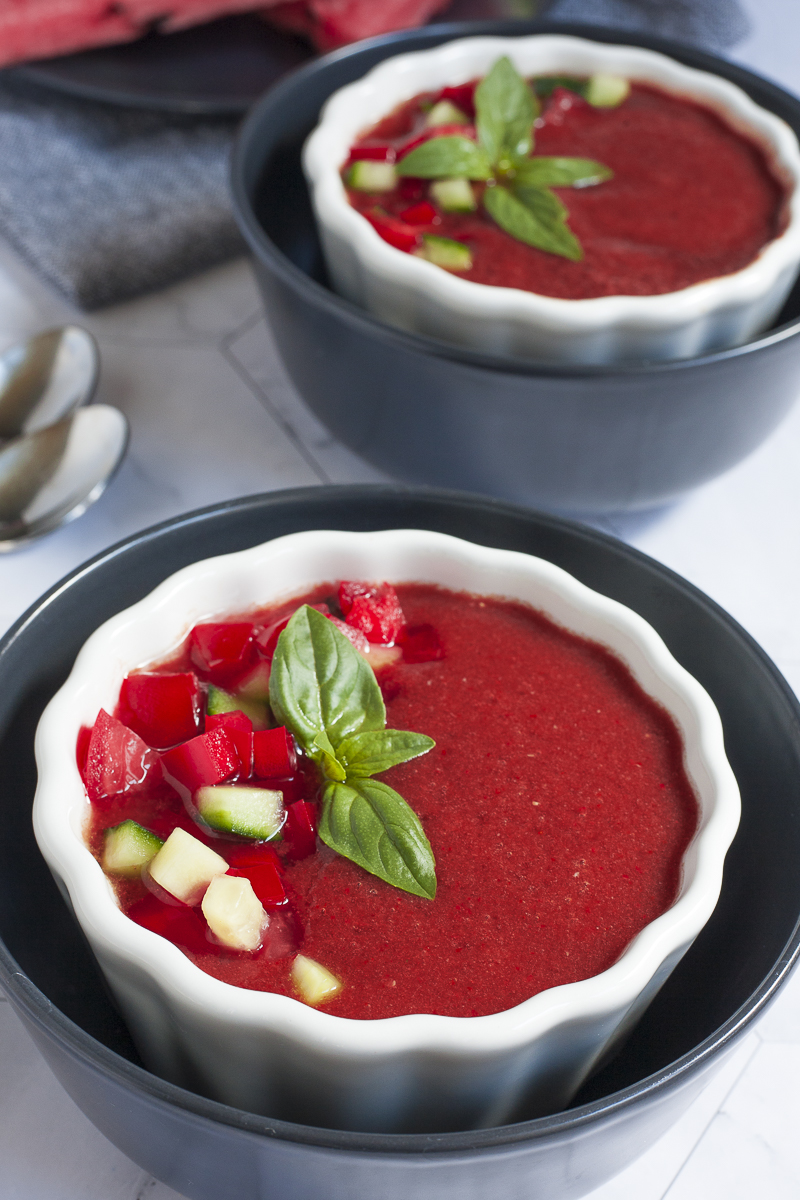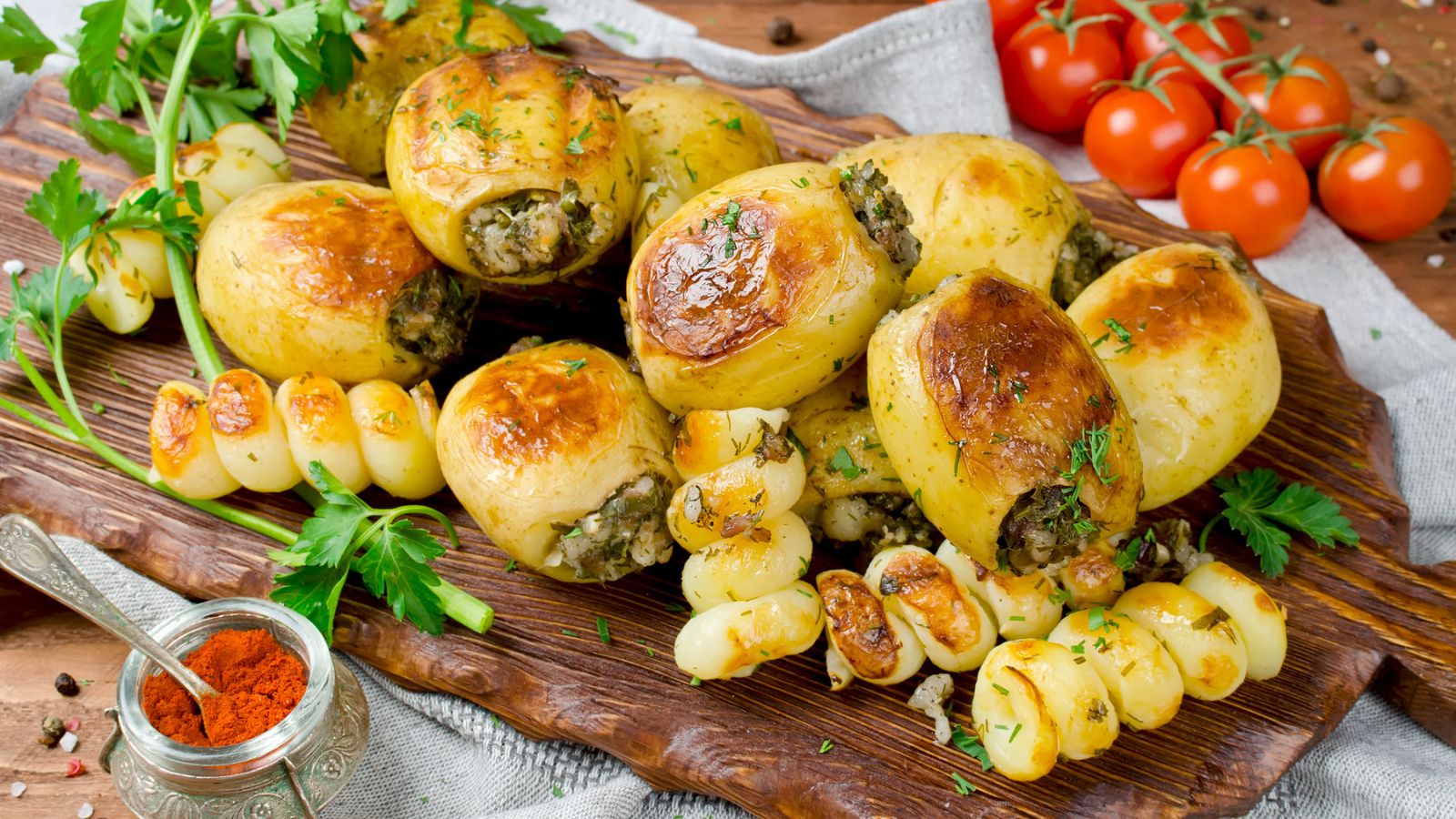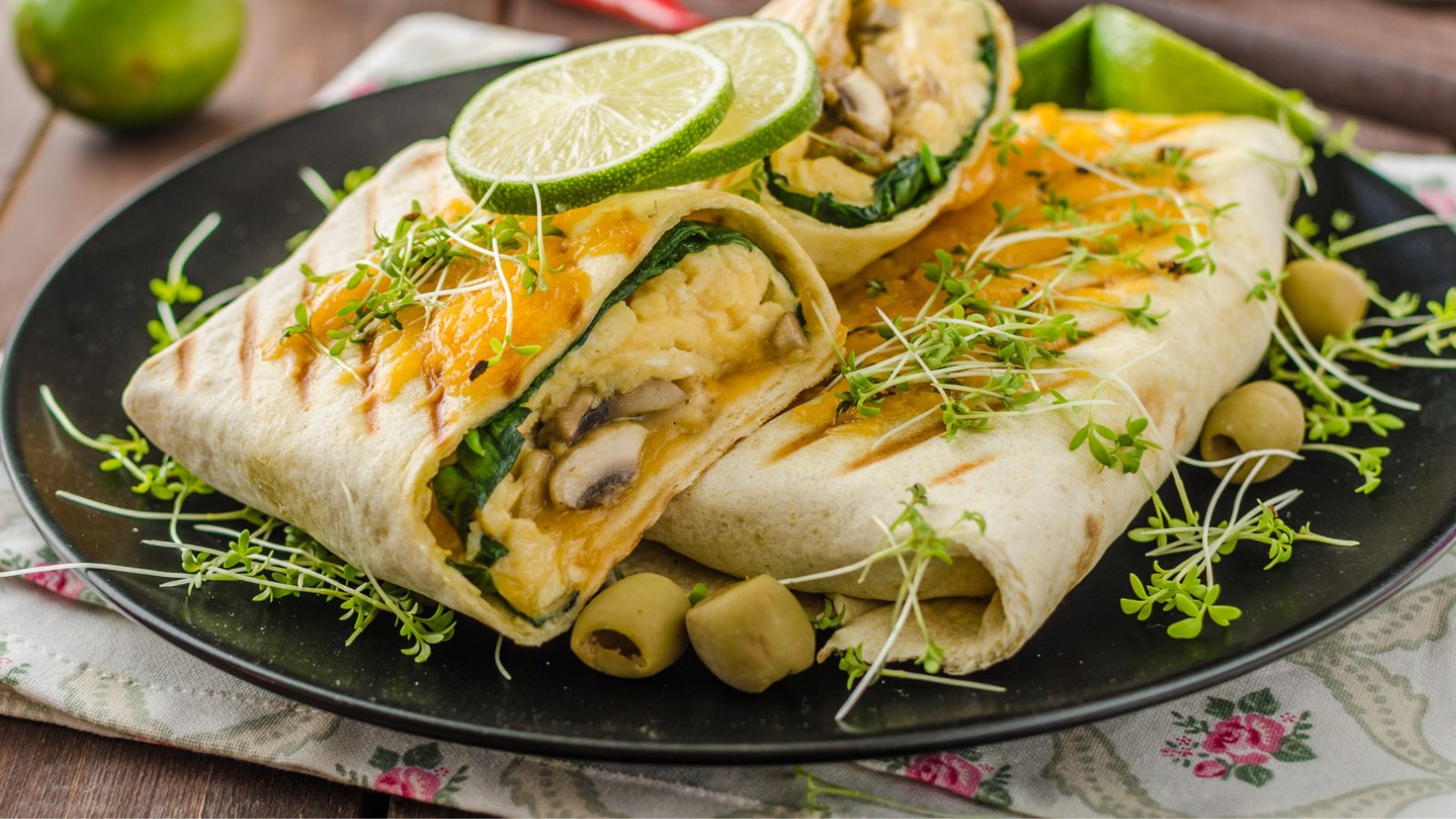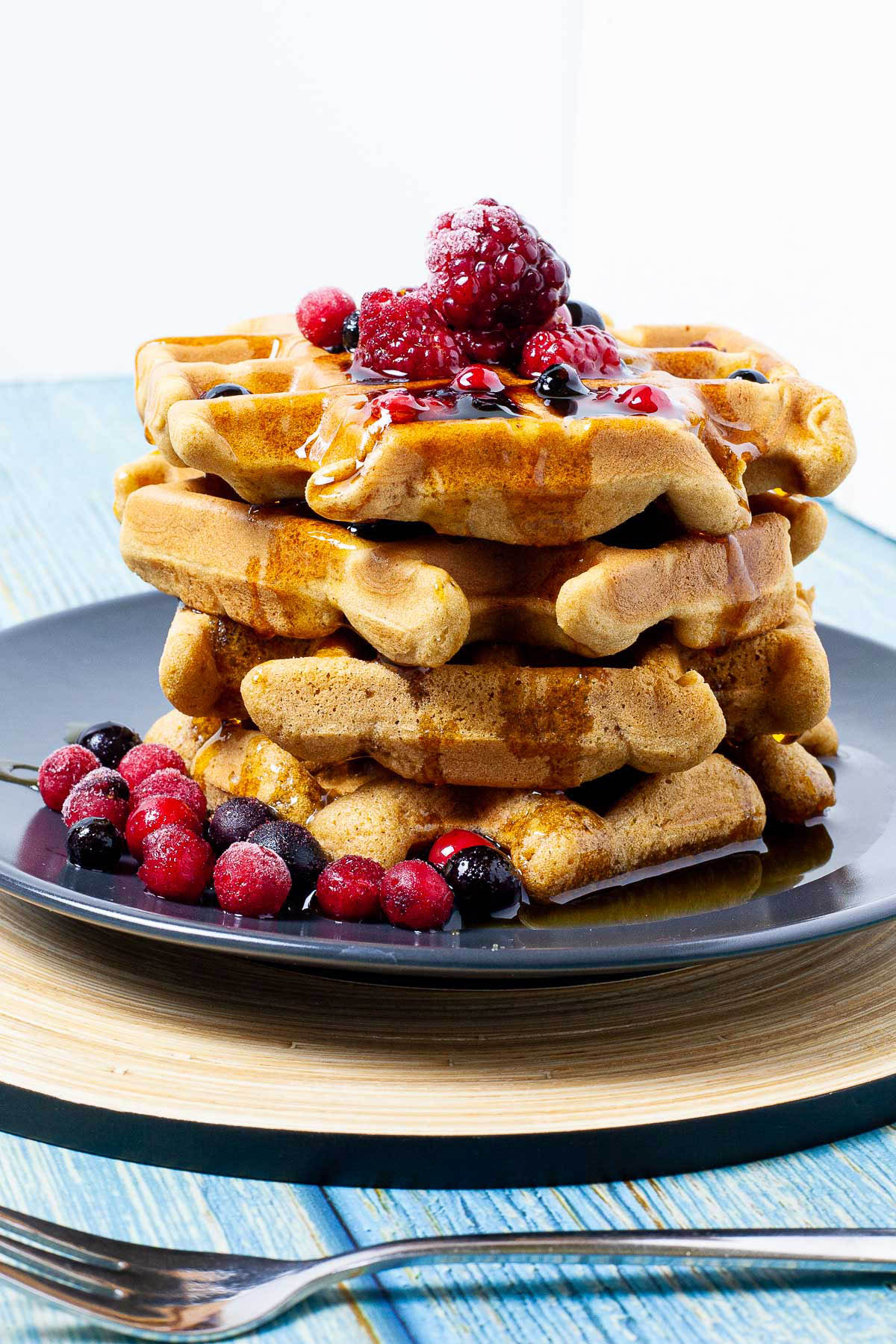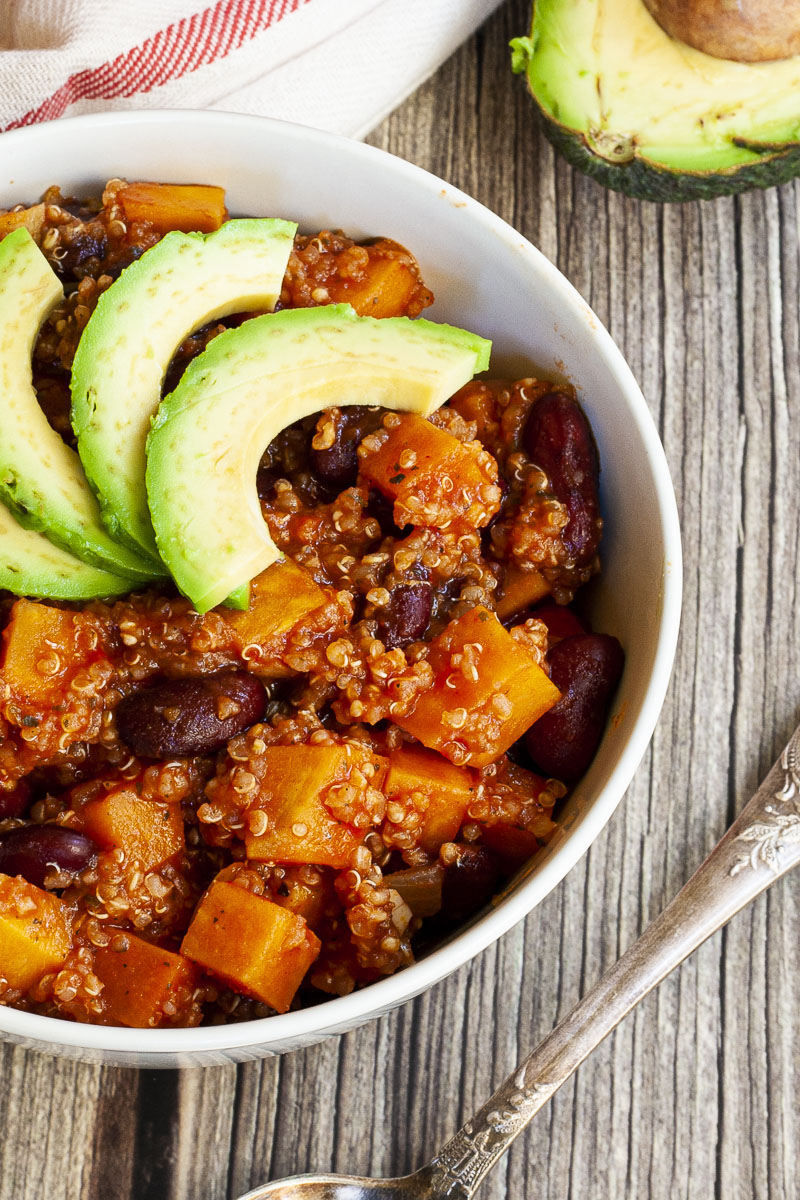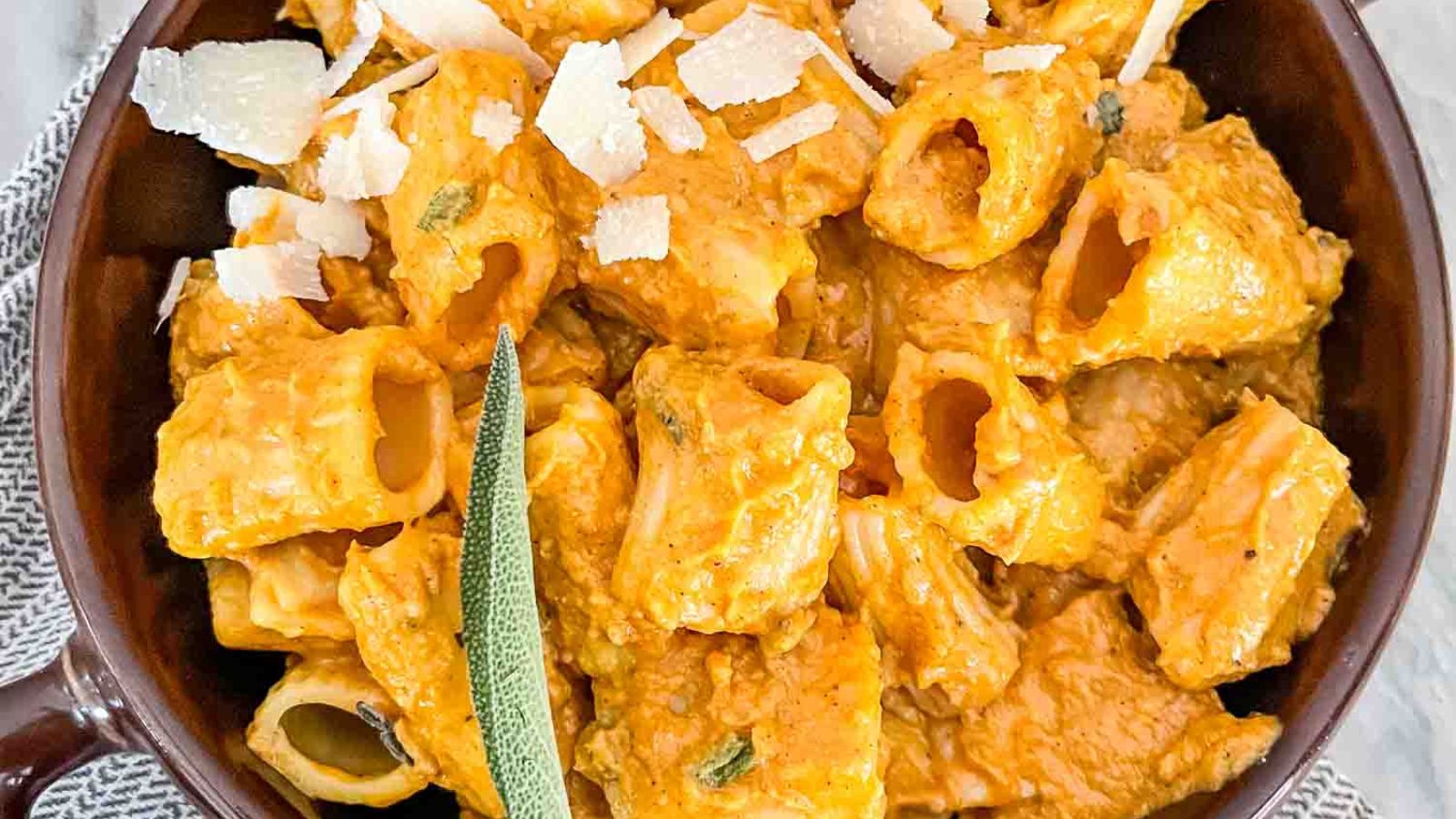Blueberry Banana Bread
Banana bread meets blueberry muffin in this fabulously fruity morning mashup that’s quick and easy (there’s a reason they’re called quick breads after all, no electric mixer required!) This moist, tender, and flavorful banana bread is studded with fresh...
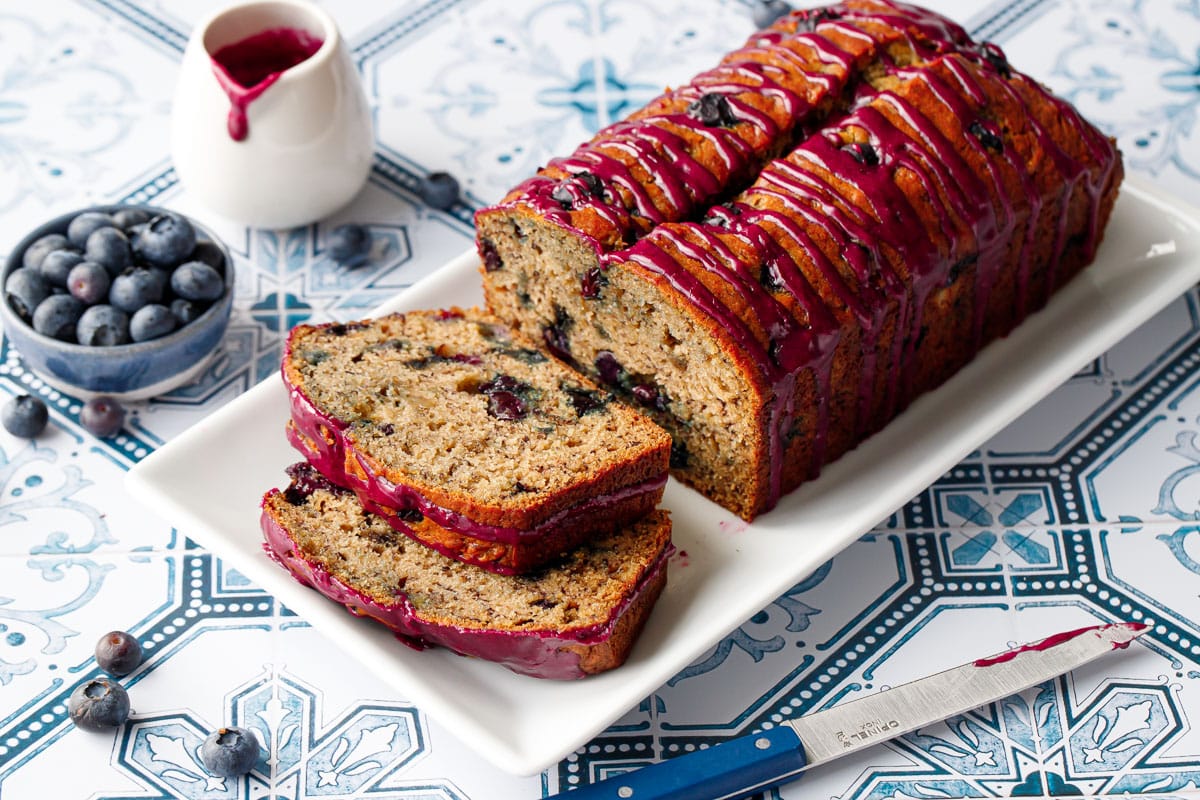
Banana bread meets blueberry muffin in this fabulously fruity morning mashup that’s quick and easy (there’s a reason they’re called quick breads after all, no electric mixer required!)
This moist, tender, and flavorful banana bread is studded with fresh blueberries (but frozen works too!) and drizzled with a vibrant blueberry glaze for a fruity twist on a morning staple.
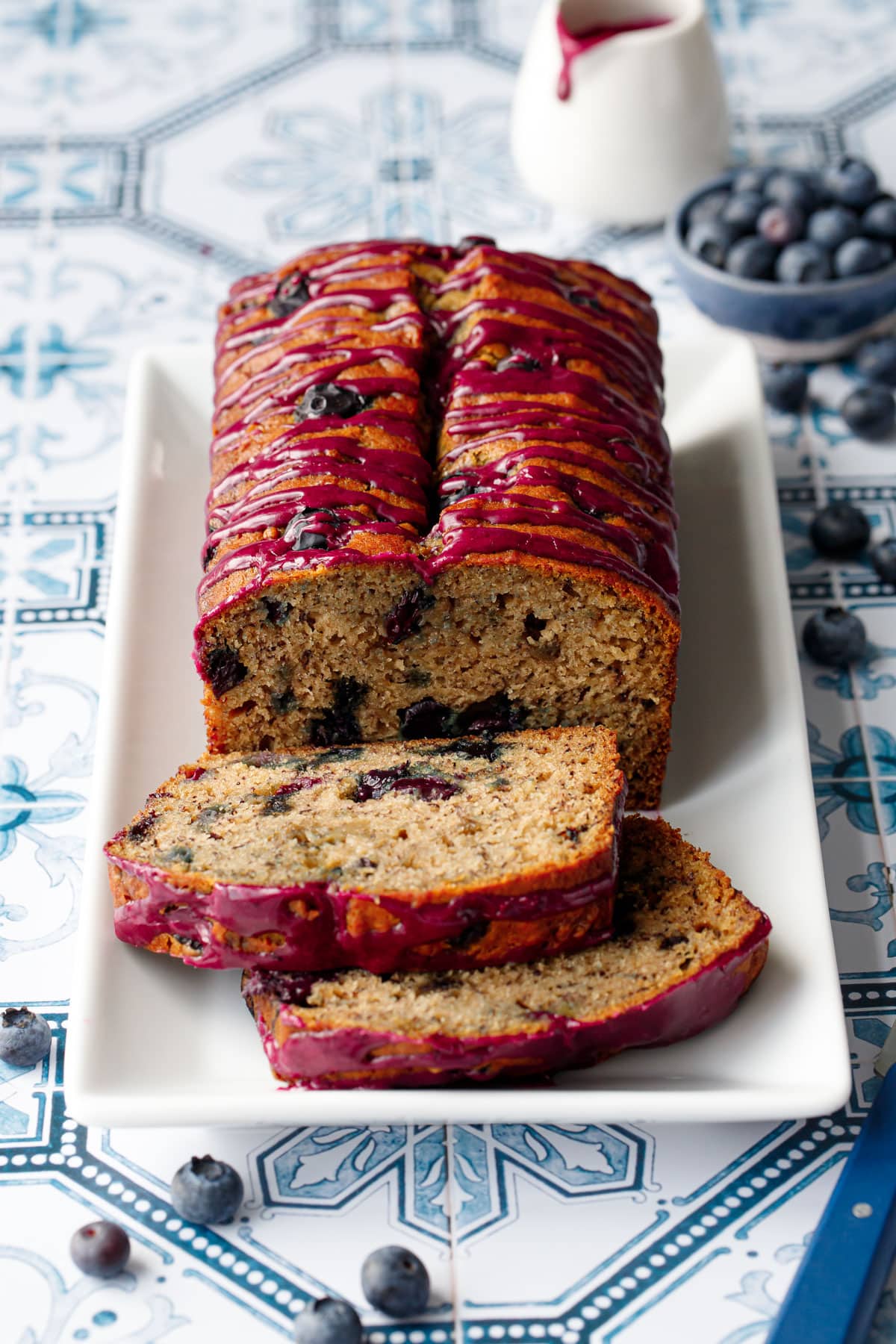
Last year’s strawberry banana bread was downright delightful, so I figured, why not do a blueberry version?
Not only is it less work than the strawberry version, but since blueberries have a lower water content and are more ‘contained’ in their own little skins, the whole macerate/syrup step isn’t needed, just a quick toss with some flour then fold the berries straight into the banana bread batter.
At this point, I’ve got banana bread recipes for every season: strawberry for spring, blueberry for summer, pumpkin banana bread for fall, and for winter might I suggest my double chocolate banana bread or even black sesame swirl banana bread (trust me it’s lovely!)
I’ve also got recipes for banana bread muffins if that’s more your style (and know that any banana bread recipe, including this one, can easily be made in muffin form! For reference 1 standard sized loaf is equal to about 12 muffins.)
Question though, how many banana bread recipes is too many? 🤔 Does such a limit even exist?
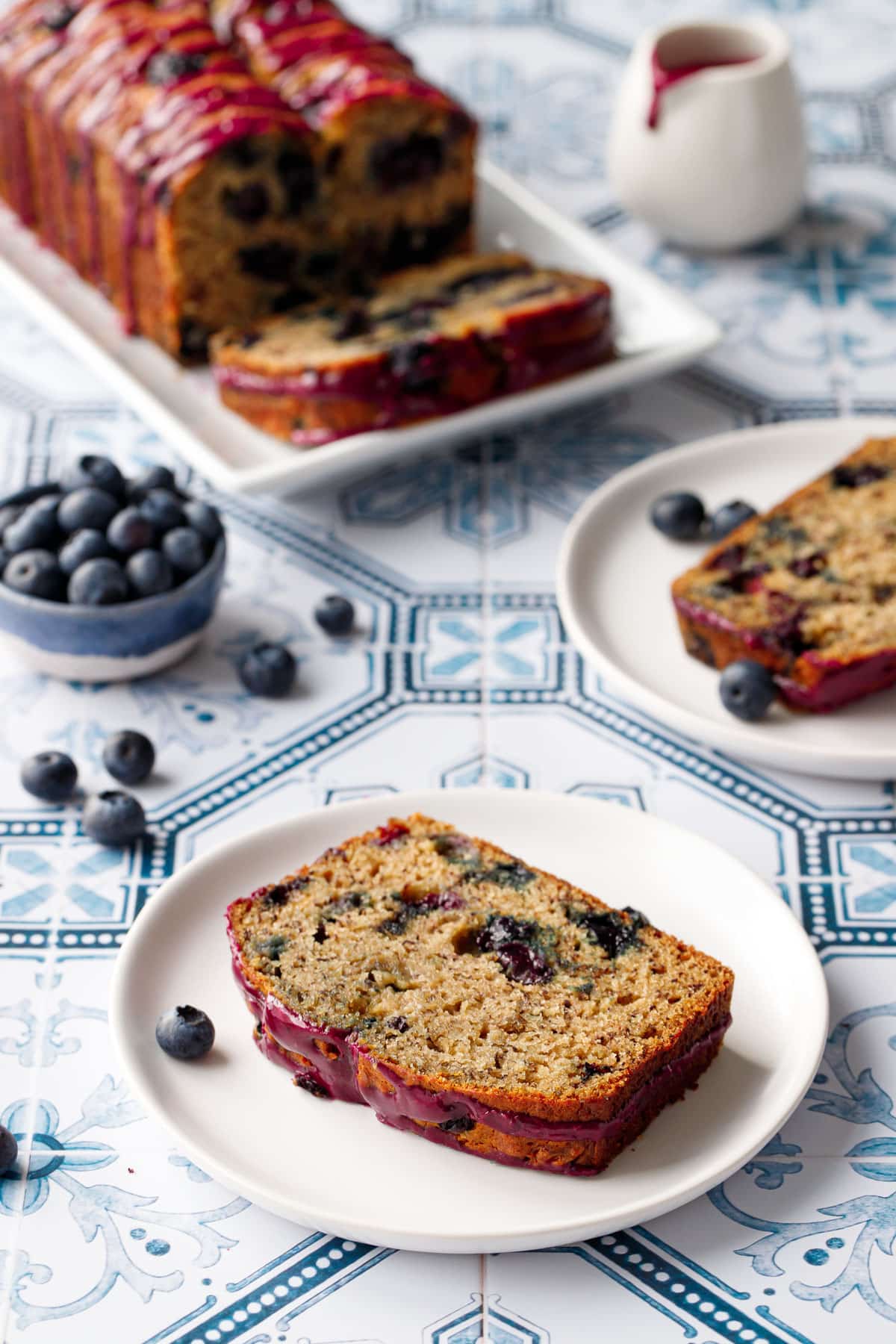

There’s just something so satisfying about banana bread, whether it’s a slice served warm with a pat of butter alongside your morning coffee or tea, or as a quick and satisfying afternoon snack to tide you over until dinnertime.
And this blueberry version is no exception. Think of it as if a classic banana bread and the best bakery-style blueberry muffin had a baby: this would be the result. With a moist and tender crumb that’s dense but not gummy, a strong banana flavor, with bright pops of fresh blueberry in every bite. The glaze on top adds even more punchy blueberry flavor and a hit of extra sweetness (honestly those bites are the best bites).
The touch of cinnamon serves to bring out the flavor of the blueberries, cinnamon being a natural compliment to blueberries. While I definitely noticed the difference between a loaf made with cinnamon and one without, it’s not an overpowering flavor in the final product by any means; in fact you may not even know it was there if I hadn’t told you so (let’s just say this loaf definitely tastes like summer, not fall).
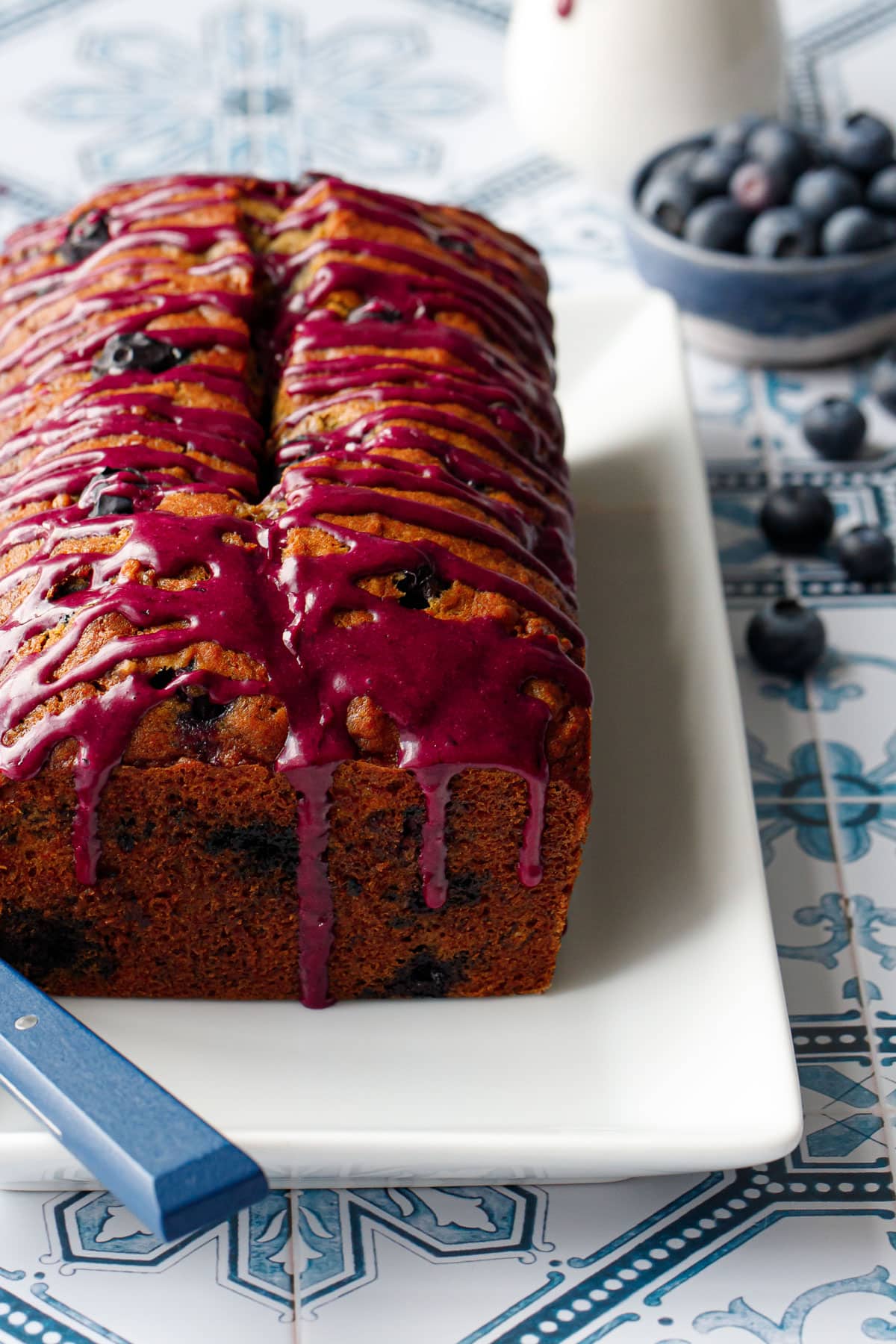
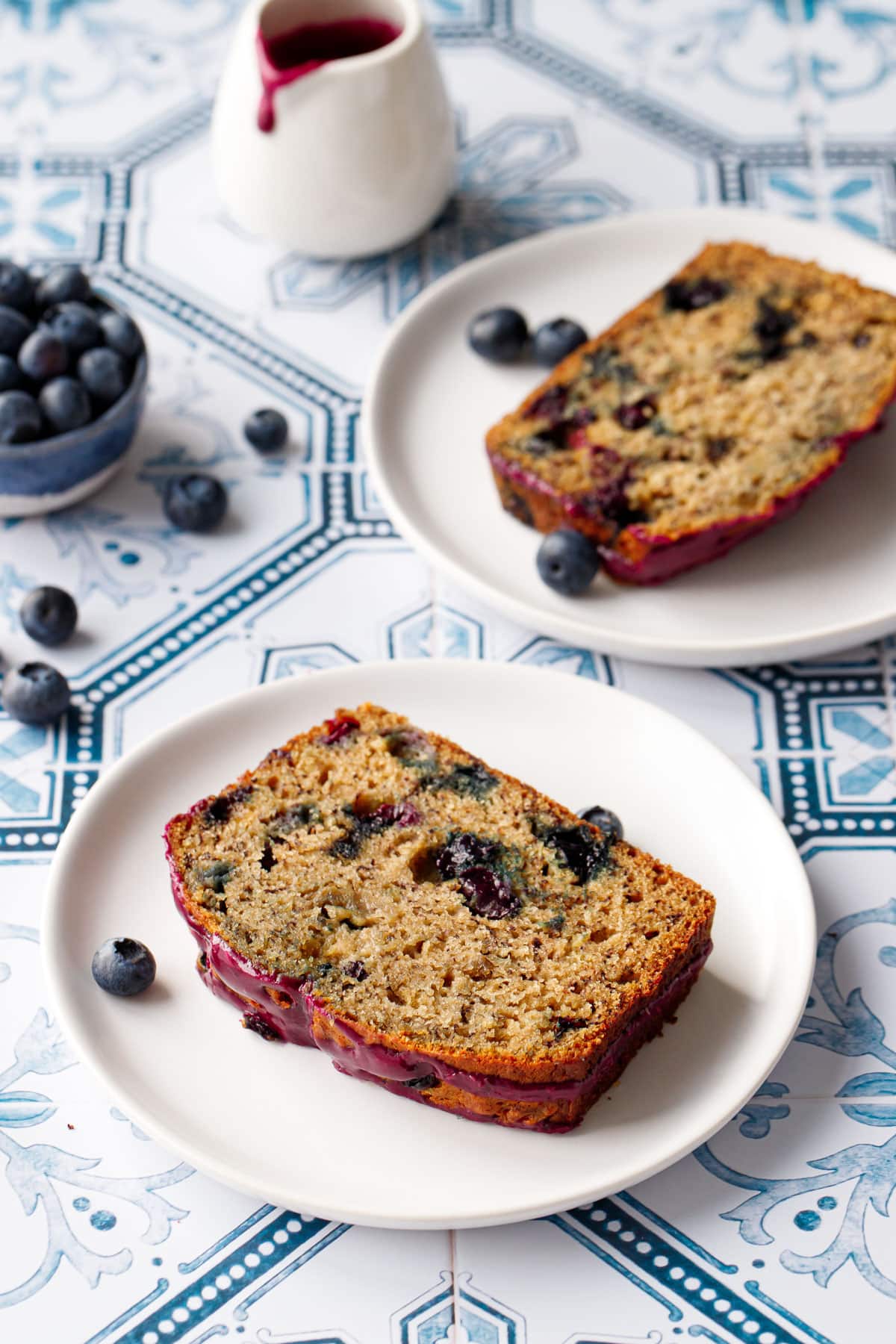
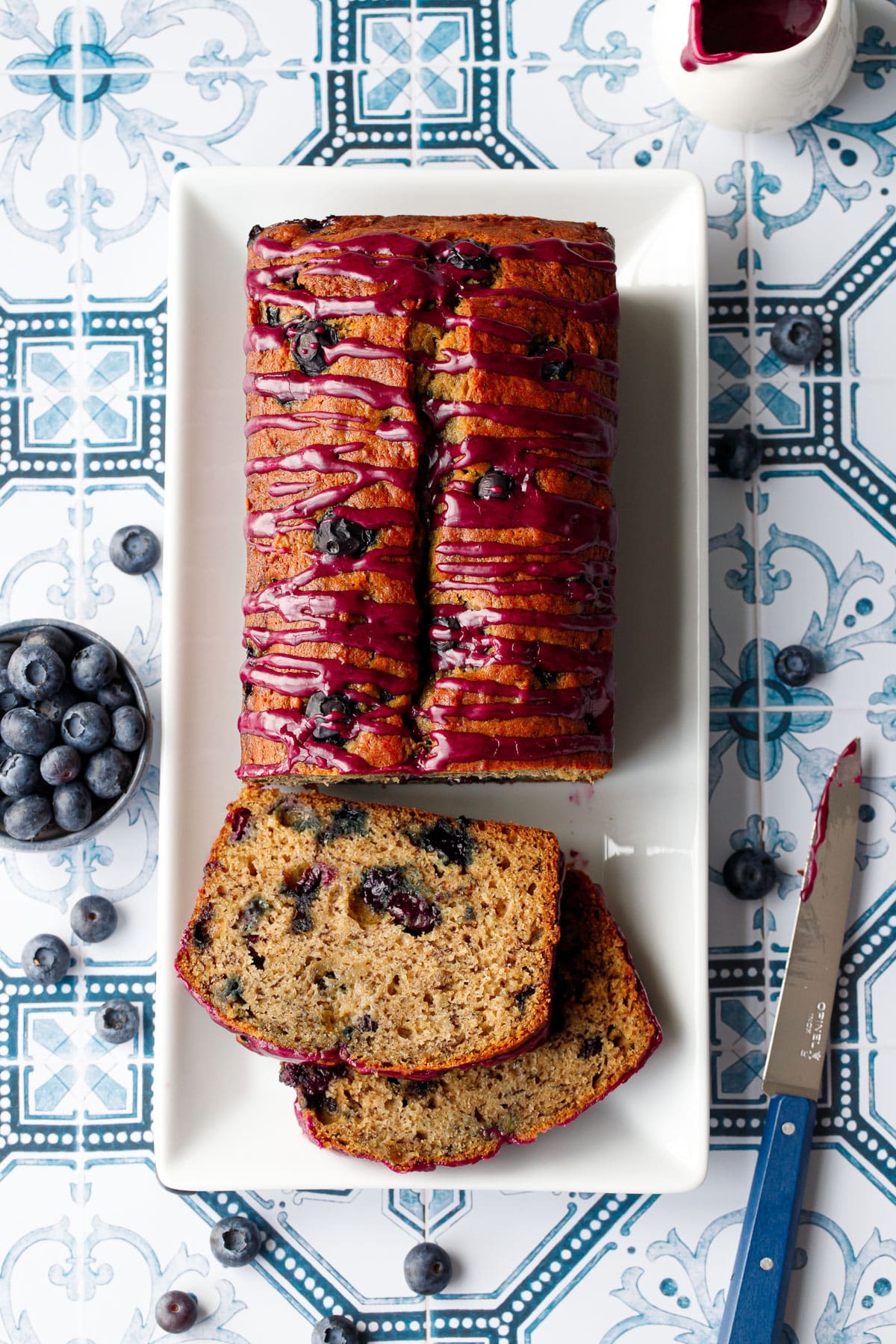
Banana bread is called ‘quick bread’ for a reason: it’s incredibly quick and easy to make, and since all the fats are liquid (melted butter), there is no electric mixer required!
I like to mix my wet ingredients in a spouted measuring cup, starting with the mashed banana; the 2 cup capacity works too but the 4-cupper gives a bit more wiggle room with less chance of spillage. Whisk all the wet ingredients together along with the sugar, then add it all, along with the melted butter, to the dry ingredients in one go.
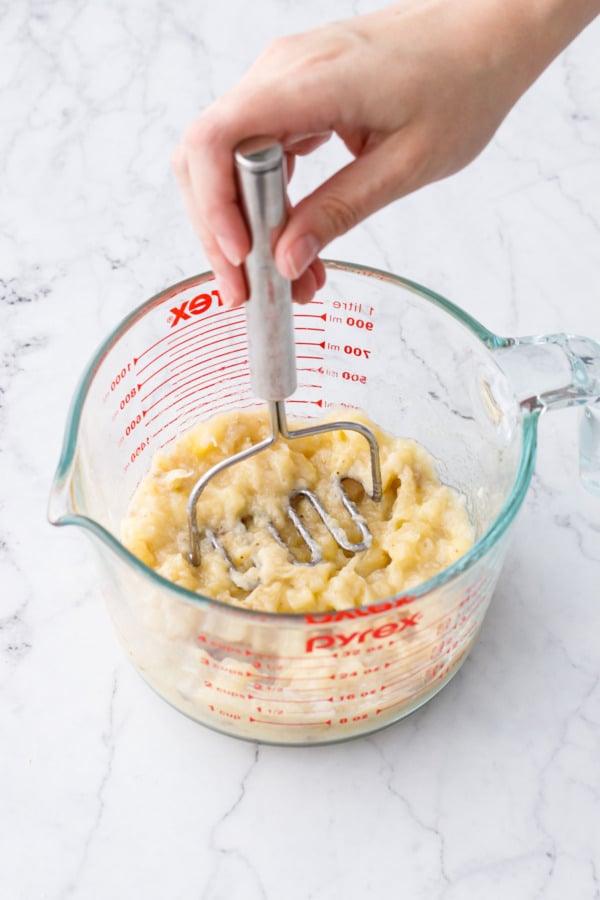 Mash ripe bananas until fairly smooth (I like to use a wire potato masher for this). You should have about one cup.
Mash ripe bananas until fairly smooth (I like to use a wire potato masher for this). You should have about one cup.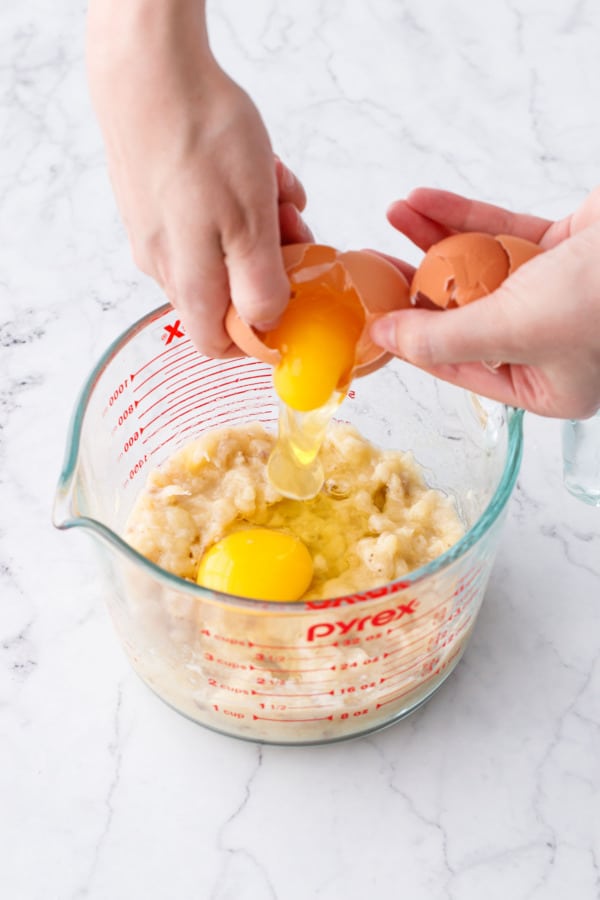 Add two eggs to bowl or measuring cup along with mashed banana.
Add two eggs to bowl or measuring cup along with mashed banana.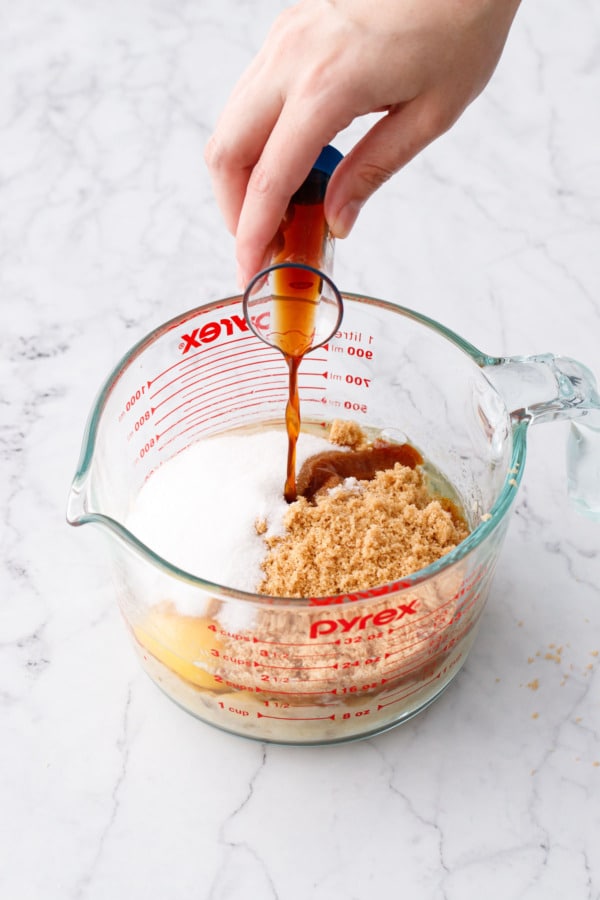 Add white sugar, brown sugar, and vanilla extract to bowl along with mashed banana and eggs.
Add white sugar, brown sugar, and vanilla extract to bowl along with mashed banana and eggs.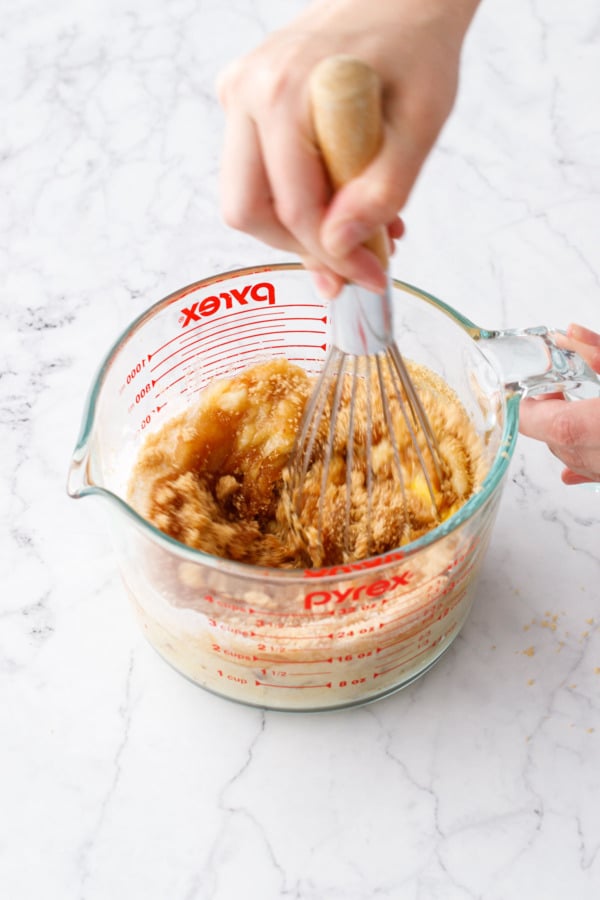 Whisk wet ingredients until evenly incorporated and mostly smooth (there will still be some chunks of banana).
Whisk wet ingredients until evenly incorporated and mostly smooth (there will still be some chunks of banana).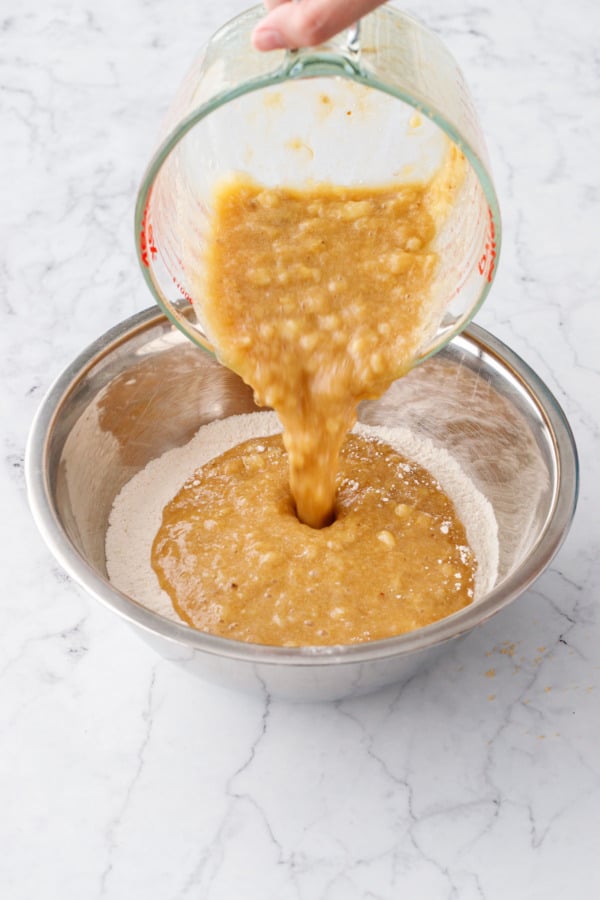 Pour wet ingredients into the mixing bowl with the dry ingredients.
Pour wet ingredients into the mixing bowl with the dry ingredients.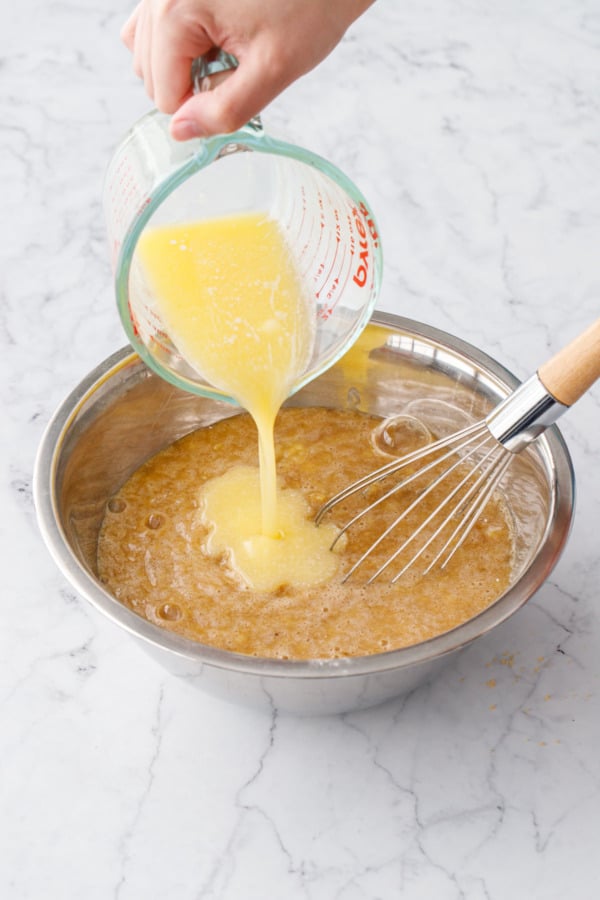 Add lukewarm melted butter to mixing bowl along with other wet ingredients.
Add lukewarm melted butter to mixing bowl along with other wet ingredients.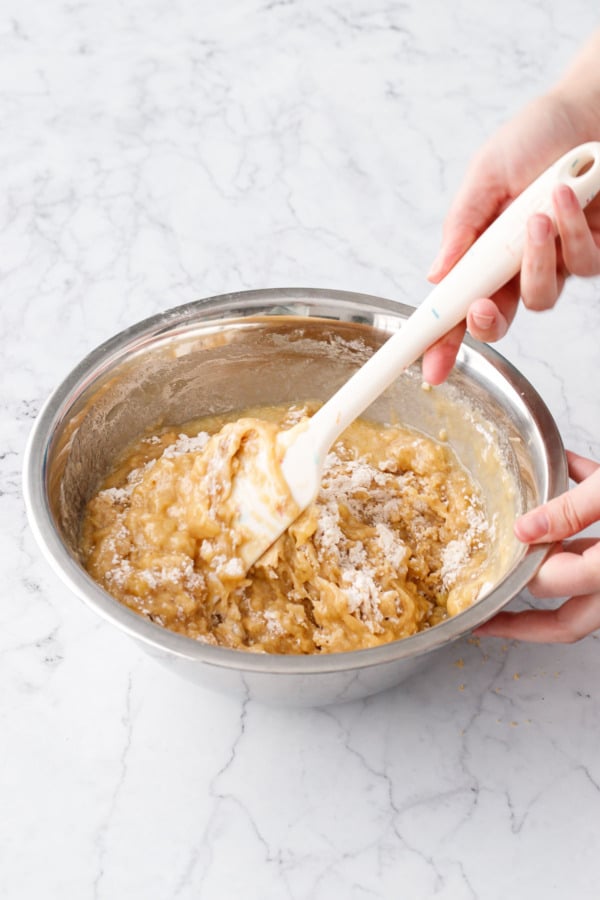 With a wide spatula, fold the wet ingredients into the dry ingredients until mostly incorporated (just a few streaks of dry flour will be visible).
With a wide spatula, fold the wet ingredients into the dry ingredients until mostly incorporated (just a few streaks of dry flour will be visible).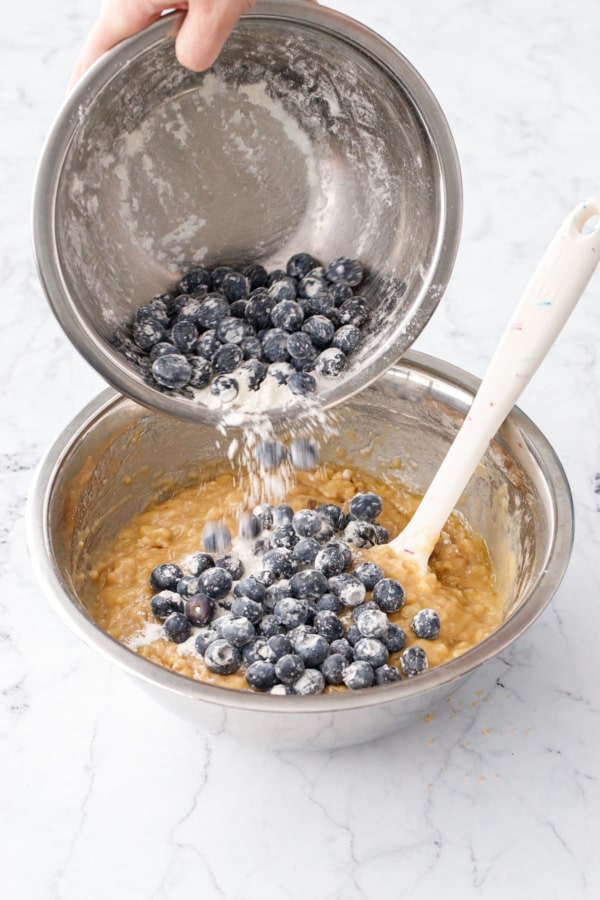 Add flour-coated blueberries into mixing bowl with just-combined batter.
Add flour-coated blueberries into mixing bowl with just-combined batter.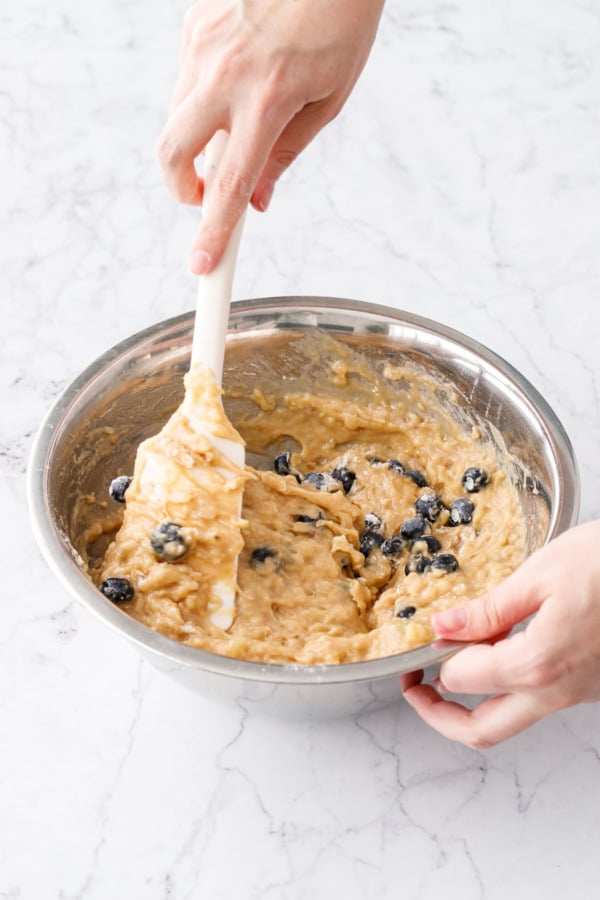 Fold blueberries into batter until evenly distributed.
Fold blueberries into batter until evenly distributed.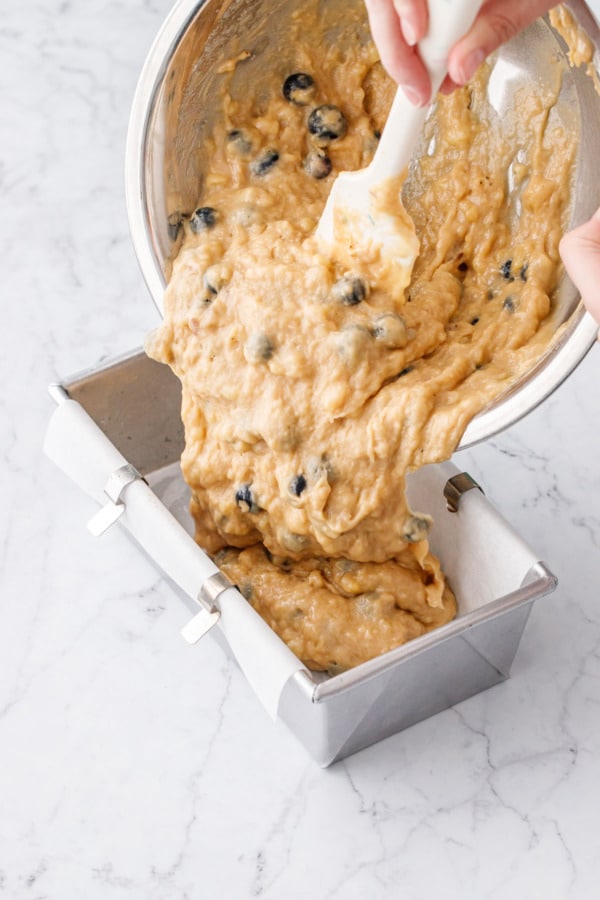 Pour batter into a lightly buttered and parchment-lined 8.5-inch loaf pan.
Pour batter into a lightly buttered and parchment-lined 8.5-inch loaf pan.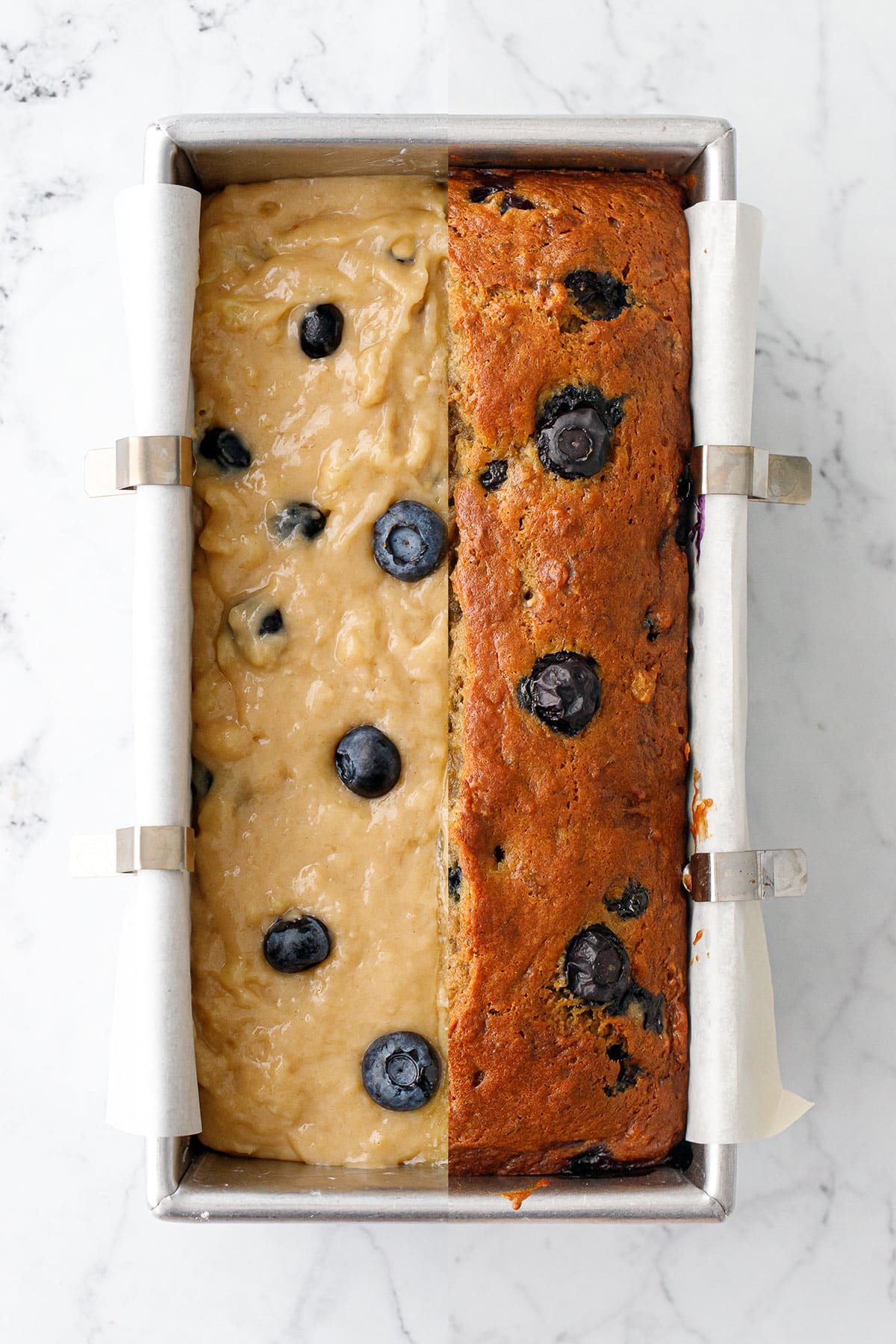
Good for a loaf.
Let’s talk loaf pan sizes for a sec.
Because you’d think a loaf pan would be a pretty standard thing, but you’d be wrong.
Turns out there are two ‘standard’ loaf pan sizes in the US: 8.5-by-4.5-inch and 9-by-5-inch (both are about 2.5 to 2.75 inches tall). It might seem like half an inch is no big deal, but it actually makes for a difference of about 2 cups of batter (!!) or as much as 25% of the total volume.
My loaf pan of choice (and what all my loaf cake recipes are written for) is the smaller 8.5-by-4.5-inch size, specifically this commercial loaf pan which I love for it’s nice sharp corners. This size is commonly sold as a one pound loaf pan. I recommend a light-finished metal pan to ensure the most even baking; darker metal finishes can result in over-cooked sides and thicker glass or ceramic pans conduct heat very differently and can cause issues and unevenness with the final bake.
You do not actually need a nonstick pan (most of which have darker finishes anyway), rather, just a strip of parchment (NOT waxed paper) pressed on the long edges and bottom, and a generous coat of butter along the short sides should do just fine. Run a knife inside the short sides when it comes out of the oven, then use the parchment as a sling to ‘lift’ the whole loaf out of the pan.
If you only have the larger 9×5 size, that’s totally fine, you’ll just end up with a wider, squattier loaf. The baking time will actually be less for the larger pan to account for the thinner depth (so start checking at maybe 45-50 minutes).
Conversely, recipes written for the larger 9×5 loaf pan size won’t always work for the smaller size pans as they may have too much batter that could overflow in the oven (and that’s a mess no one wants to clean up). So the lesson here is pay attention to the specific size as called for in the recipe!
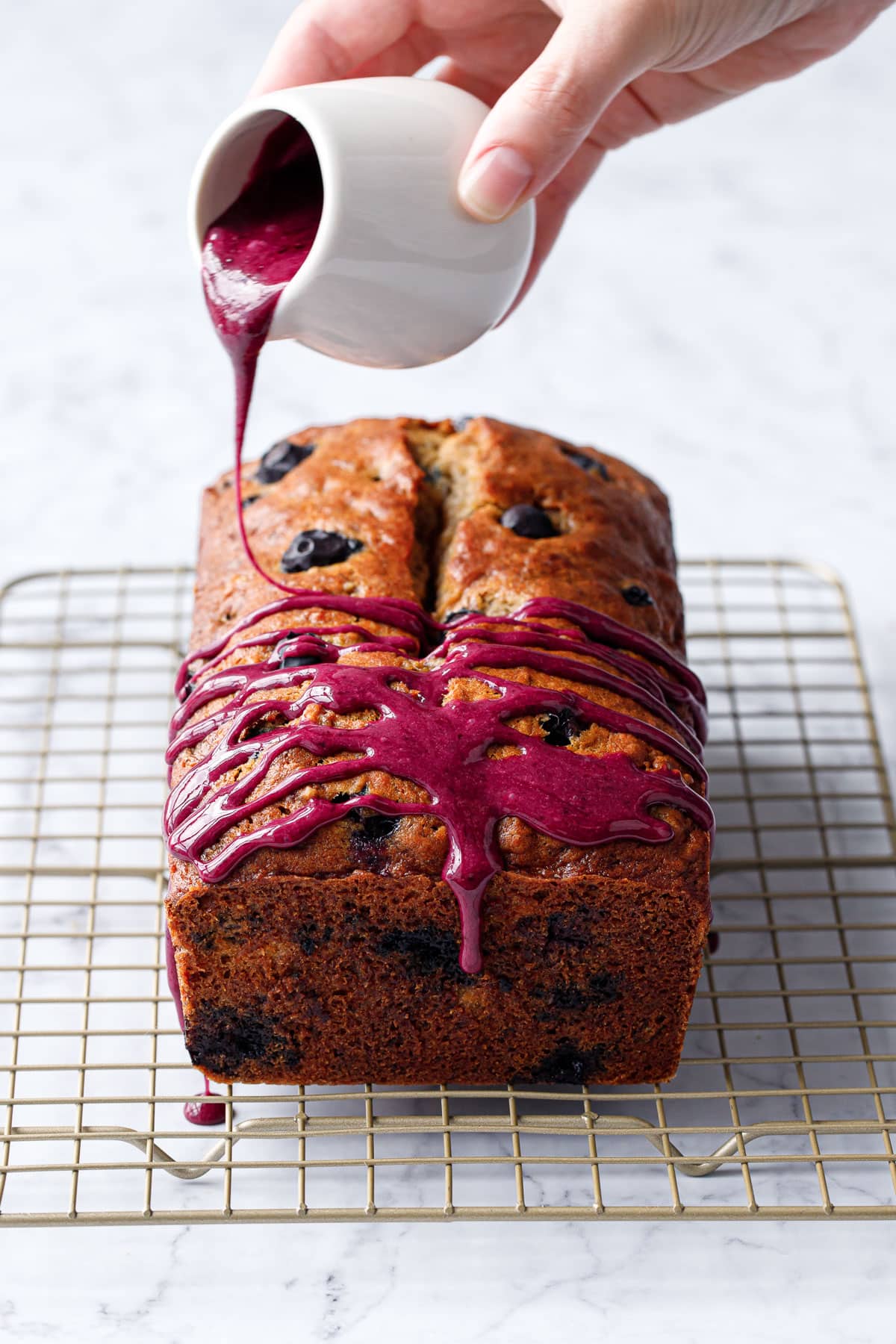
The blueberry glaze is completely optional, the bread is delicious in its own right, but I can’t help but love the gorgeous magenta drizzle on top (it’s—literally and figuratively—the icing on the cake bread).
The glaze also adds an extra dose of sweetness and blueberry flavor into each bite, but you can certainly skip it if you prefer.

Peeling Groovy.
The perfect bananas for banana bread are the ones so ripe you can smell them from across the room, and you may even worry they’ve turned on you. The peels should be more brown than yellow at this point, and can be easily mashed by hand into a smooth(ish) puree-like consistency.
Why do banana bread recipes call for really, really ripe bananas? They’re sweeter, for one, as more of the starch has broken down into sugar, making them perfect for baked goods. The extra-intense banana flavor will shine through more prominently in the final finished product. Not to mention the softer texture makes them easier to mash and incorporate into a batter.
I often have an abundance over-ripe bananas on hand, but lately Taylor has been eating every last one of them before they are fully ripe. Why is it that you always seem to have either too many over-ripe bananas or all the bananas are firm and bright yellow with nary a brown spot in sight (the latter usually occurs precisely when the banana bread cravings are at their peak, of course). There’s never an in-between. Why is that?
Luckily, if you absolutely must have banana bread right this minute but your bananas aren’t quite over-ripe enough, you can force-ripen bananas in the oven!
To force-ripen bananas, simply bake unpeeled bananas at 300 degrees F for 15 to 20 minutes or until the bananas are entirely brown and a little juicy. Let cool completely, then remove peels and proceed as instructed.
On the other side of the spectrum, if you find yourself with way too many overripe bananas at one time, you can always freeze them for later! I like to peel them first, then store in an airtight bag (don’t forget to label it with the date and # of bananas inside because I guarantee you will not remember later). Let thaw before mashing and using in the recipe as written.
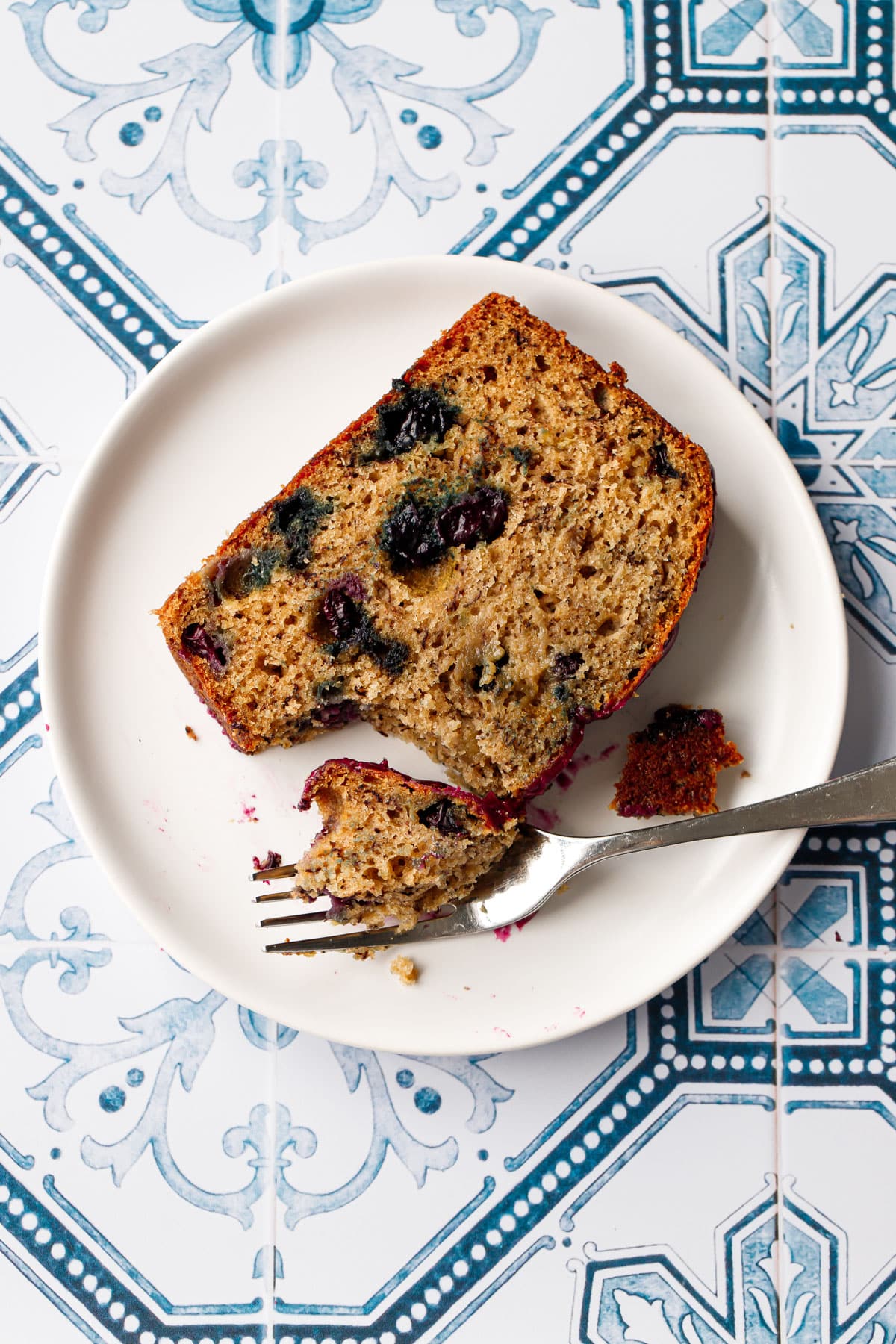
Ingredient Notes & Substitutions
Ripe Bananas: Obviously banana bread needs bananas, and the riper the better (more brown than yellow is my general rule). You’ll need about 2 large or 3 small-ish bananas for this recipe, which will yield about 1 cup of mashed banana.
AP Flour: I used a regular unbleached AP flour for this recipe. I have not tested it with any GF flour blends, and while I imagine it should work reasonably well, though you may not get as much rise or a perfect peak on top. Using whole wheat flour instead of AP would result in a denser texture, so I’d recommend using maybe 25%, or 50% WW at the most, if you opt to do this.
Melted butter: Melted and cooled to lukewarm (this second part is important!) You can also use a vegan butter substitute if you want a dairy-free variation.
Sugar/brown sugar: A mix of sugars helps balance moisture, flavor, and sweetness. You could use all brown sugar, but not the opposite (all white sugar doesn’t retain moisture or have nearly as much flavor as brown sugar). I do not recommend reducing the sugar in this recipe as your banana bread will likely be too dry (sugar is for more than just sweetness!)
Cinnamon: A little bit of cinnamon adds depth and enhances the natural fruitiness of the blueberries, without being an overpowering flavor in the final product. If you want to taste the cinnamon, feel free to increase it; you can also leave it out entirely.
Blueberries: You can use fresh or frozen blueberries here, though keep in mind frozen berries will release more moisture than fresh will (so the pockets around the berries may be slightly soggy). I recommend rinsing your frozen berries in cool water (this will partially thaw them as well as rinse of some of the excess juice and prevent your batter from turning completely blue), then pat dry with paper towels. Fold into batter, stirring as little as possible to prevent blue streaks.
Dried blueberries would work as well (at least in the batter, not the glaze, obviously), though the result will be quite a bit different in terms of texture and flavor.
You can also omit the blueberries entirely from this recipe, you’ll just have a classic banana bread in that case (or you can swap the mix-ins for others like chocolate chips or chopped nuts).
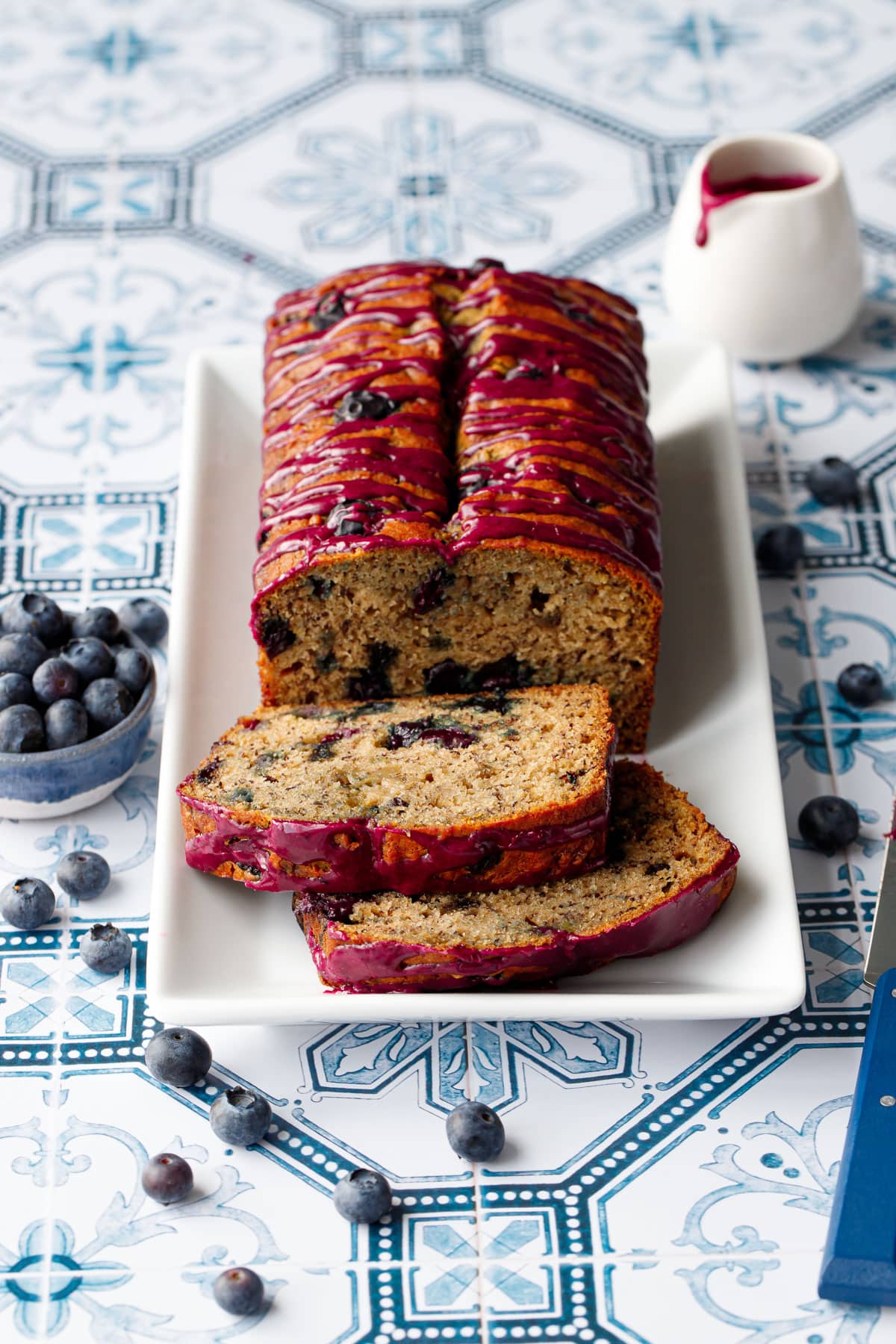
So now that we’ve got blueberry and strawberry covered, should we do raspberry banana bread next? (And actually, I think raspberries could easily be substituted in this recipe without any other changes, so maybe it doesn’t need its own dedicated post, or does it?)
Oooh, or maybe peach banana bread? Apricot? GUAVA??? Hello, the possible combinations are infinite!
Blueberry Banana Bread
Prep Time: 30 minutes
Cook Time: 1 hour
Total Time: 2 hours
Banana bread meets blueberry muffin in this fabulously fruity morning mashup, studded with fresh blueberries and drizzled with a vibrant blueberry glaze.
For Banana Bread:
▢ 1¾ cups / 218 g all-purpose flour▢ 1 teaspoon baking soda▢ ½ teaspoon fine sea salt▢ ¼ teaspoon ground cinnamon▢ 1 cup / 275 g mashed ripe banana*, from 2 large or 3 small bananas▢ ½ cup / 105 g packed light brown sugar▢ ¼ cup / 50 g granulated sugar▢ 2 large eggs, at room temperature▢ 2 teaspoons vanilla extract▢ ½ cup / 113 g unsalted butter, melted and cooled slightly▢ 1 cup / 150 g blueberries▢ 1 tablespoon all-purpose flourFor Glaze:
▢ ½ cup / 85 g blueberries▢ 1 teaspoon lemon juice▢ ½ cup / 60 g powdered sugar, siftedPreheat oven to 350 degrees F. Lightly butter an 8½-by-4½-inch loaf pan; press and 8½-inch wide strip of parchment paper into bottom of pan so it lines the bottom and long edges, leaving two overhangs on either side.
Melt butter in the microwave or a small saucepan over low heat; set aside and let cool to lukewarm.
In a bowl, whisk together flour, baking soda, cardamom, and salt.
In another bowl, mash bananas until smooth. Whisk in sugar, brown sugar, eggs, and vanilla until evenly incorporated.
Add banana mixture and lukewarm melted butter to dry ingredients, and mix until just incorporated and no dry ingredients remain (batter will still be slightly lumpy).
Toss blueberries with 1 tablespoon flour (this will prevent them from sinking). Fold into batter until evenly incorporated, then pour batter into prepared loaf pan. If desired, butter or oil the edge of a bench scraper and use that to imprint a fine line of fat down the center of the loaf (this will help form a nice defined crack as it bakes, but no worries if you skip this step).
Bake for about 55 to 65 minutes or until a toothpick inserted in the deepest part of the bread comes out with moist crumbs but no longer any gooey batter. If using a 9-by-5-inch pan, the loaf will be shallower so the cook time will be slightly less (check after 45 minutes or so).
Remove from oven and place pan on a wire rack to allow bread to cool for 30 minutes, then use the parchment overhang as handles to gently lift the loaf out of the pan and place on a wire rack.
For glaze, combine blueberries and lemon juice in a small saucepan set over medium heat. Smash with a potato masher or the back of a wooden spoon, and bring to a simmer for 1 minute or until softened and juicy. Remove from heat and strain through a fine mesh sieve; you should have 3-4 tablespoons of blueberry 'juice'.
Sift powdered sugar into a bowl, add 2 tablespoons of blueberry juice, 1 tablespoon at a time, whisking until smooth and no clumps remain. Continue adding blueberry juice, 1 teaspoon at a time, until the glaze reaches the desired consistency (you may have leftover blueberry juice). Drizzle or brush over top of cooled loaf.
Let glaze set and loaf cool completely before slicing and serving. Store in an airtight container for up to 1 week.
All images and text ©
for Love & Olive Oil.
Let us know what you think! Leave a Review below or share a photo and tag me on Instagram with the hashtag #loveandoliveoil.
There may be affiliate links in this post. We are a participant in the Amazon Services LLC Associates Program, an affiliate advertising program designed to provide a means for us to earn fees by linking to Amazon.com and affiliated sites.

 BigThink
BigThink 







